How To Fix Screw Holes In Kitchen Cabinets
Kitchen Cabinets: 9 Easy Repairs
Are you bugged by kitchen cabinets that don't work quite right? Broken latches, loose door hinges, sticking drawers—are they driving you bonkers? Read on for easy fixes to these and other common cabinet problems.
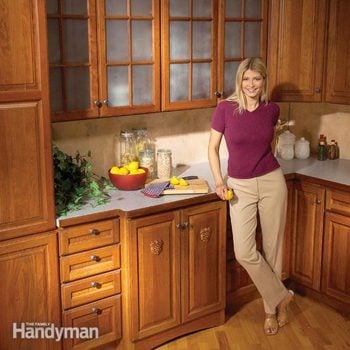 Family Handyman
Family Handyman
Sometimes, it's the little things that drive us crazy in the kitchen. The loose door knobs, nicked door fronts and slamming drawers. If any of these sound familiar, check out this collection of quick and easy kitchen cabinet repairs. You'll find simple solutions for many of the most common kitchen cabinet woes.
You might also like: TBD
Adjust hinges on misaligned doors

Adjust depth and side screws
Euro hinges are designed for easy adjustment. If the door isn't flush with the doors next to it, adjust the depth screw. This screw moves the door in or out. Some depth screws move the door as you turn them. But with most, you have to loosen the screw, nudge the door in or out and then tighten the screw. If your hinges don't have depth screws, start with the side screws. These move the door from side to side. In some cases, you have to loosen the depth screw slightly to adjust the side screw.
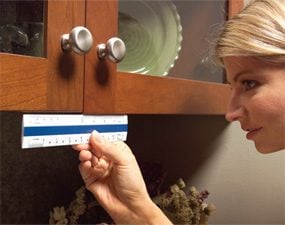
Perfect one door before adjusting the second
If the door is flush and parallel with other doors but too high or low, use the mounting screws to raise or lower the mounting plates. Loosen the screws at both hinges, slide the door up or down and tighten the screws. Some mounting plates adjust by turning a single screw. Check the fit of the door after each adjustment. With double doors like these, perfect the fit of one door first, then align the other door.
Adjust or replace bad latches
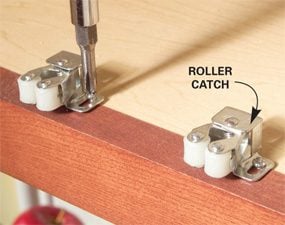
Replace and adjust the catch
Most newer cabinets have self-closing hinges that hold the doors shut. Others have magnetic or roller catches. A catch that no longer keeps a door closed is either broken or out of adjustment. Catches are fastened with two screws, so replacing a damaged catch is simple. Adjustment is just as simple, but you might have to readjust the catch a couple of times before you get it right. Loosen the screws, move the catch in or out, and tighten the screws. If the door doesn't close tightly, try again.
Add bumpers to banging doors
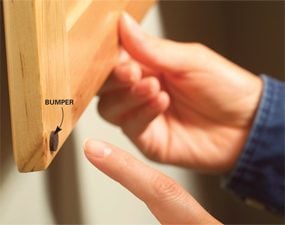
Place bumpers at top and lower corners
Tired of listening to those cabinet doors bang shut? Peel-and-stick door and drawer bumpers are the solution. Get a pack of 20 at a home center for $2. Make sure the back of the door is clean so the bumpers will stick, then place one at the top corner and another at the bottom.
How to Fix Drawer Slides: Replace worn-out drawer slides
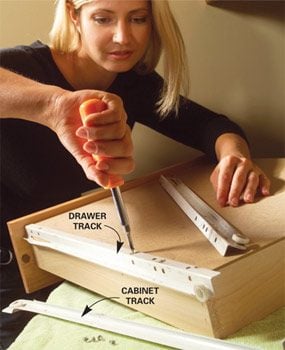
How to Fix a Drawer: Replace with identical slides
If you find that slides are bent, rollers are broken or rollers won't turn even after lubricating, replacement is the best solution. To keep the project simple, buy new slides that are identical (or almost identical) to the old ones. That way, replacement is an easy matter of unscrewing the old and screwing on the new. Remove a drawer track and a cabinet track and take them shopping with you. You'll find slides at home centers for $5 to $15 per drawer.
How to Fix a Drawer: Lubricate sticking drawers
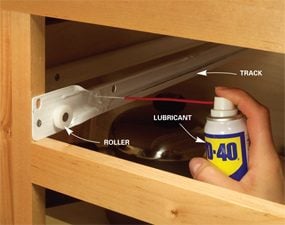
How to Fix Drawer Slides: Spray lubricant on tracks and rollers
A few minutes of cleaning and lubricating can make drawer slides glide almost like new. Start by removing the drawers so you can inspect the slides. You can remove most drawers by pulling them all the way out, then either lifting or lowering the front of the drawer until the wheels come out of the track. Wipe the tracks clean and coat them with a light spray lubricant. Also lubricate the rollers and make sure they spin easily.
How to Fix a Drawer: Repair a broken drawer box
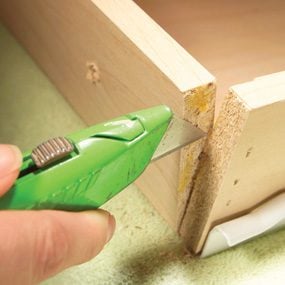
How to Fix a Drawer: Remove fasteners and old glue
Don't put up with a broken corner joint on a drawer. Fix it before the whole drawer comes apart. Remove the drawer and then remove the drawer front from the drawer box if possible. Most fronts are fastened by a couple of screws inside the box. Remove nails, staples or screws from the loose joint and scrape away old glue with a utility knife.
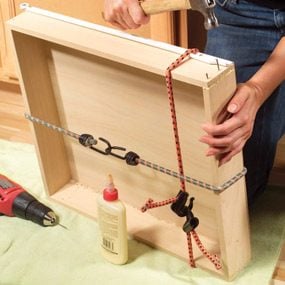
Predrill nails holes and glue the joint
Predrill 1/16-in. holes for nails, apply wood glue to the joint and nail it together with 1-1/2 in. finish nails. Wood glue will make a strong repair if there's wood-to-wood contact at the joint. If the wood at the joint is coated, use epoxy instead of wood glue.
Glue loose knobs
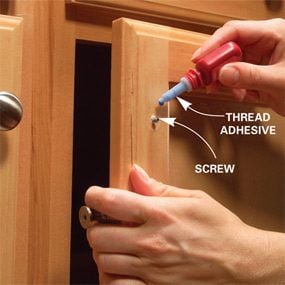
Glue knobs in place
Any handle or knob that comes loose once is likely to come loose again. Put a permanent stop to this problem with a tiny drop of thread adhesive like Thread Lok (about $3 at home centers). Don't worry; if you want to replace your hardware sometime in the future, the knobs will still come off with a screwdriver.
Two ways to fill stripped screw holes

Fill holes with toothpicks and glue
If a screw turns but doesn't tighten, the screw hole is stripped. Here's a quick remedy: Remove the screw and hardware. Dip toothpicks in glue, jam as many as you can into the hole and break them off. Either flat or round toothpicks will work. Immediately wipe away glue drips with a damp cloth. You don't have to wait for the glue to dry or drill new screw holes; just go ahead and reinstall the hardware by driving screws right into the toothpicks.
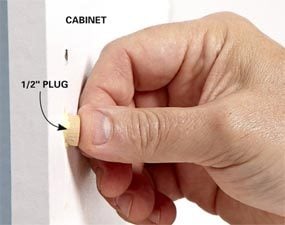
Repair a cabinet hinge screw hole with a plug
Cabinets made from particleboard work great in utility and laundry rooms, and they're fairly inexpensive. But particleboard has a major weakness—it doesn't hold screw threads very well. So if you swing the door open too fast, the force can rip the hinge screw right out of the cabinet wall. Don't worry; the fix is easy and cheap. Here's how to patch things up. You'll need a bottle of wood glue, a 1/2-in. drill bit and a package of 1/2-in.-diameter hardwood plugs (sold at home centers).
Start by removing the hinge screws on the cabinet and flipping the hinge out of your way. If the accident pulled out a large chunk of the particleboard, glue it back into place and let the glue set up before proceeding with the rest of the repair. Drill out the stripped screw hole to accept the plug. Next, fill the hole with wood glue and install the plug. After the glue dries, drill a pilot hole and install the new screw—you're all set.
Touch up nicks and scratches
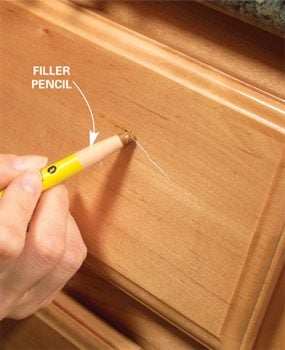
Use a stain-filled touch-up marker
If you have shallow scratches or nicks, hide them with a stain-filled touch-up marker. Dab on the stain and wipe off the excess with a rag. But beware: Scratches can absorb lots of stain and turn darker than the surrounding finish. So start with a marker that's lighter than your cabinet finish and then switch to a darker shade if needed. For deeper scratches, use a filler pencil, which fills and colors the scratch.
Similar Projects
How To Fix Screw Holes In Kitchen Cabinets
Source: https://www.familyhandyman.com/project/kitchen-cabinets-9-easy-repairs/
Posted by: pettispoicts.blogspot.com

0 Response to "How To Fix Screw Holes In Kitchen Cabinets"
Post a Comment